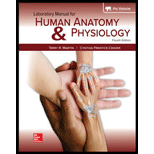
The size of the thoracic cavity is increased by contractions of all of the following muscles except the
a. diaphragm.
b. external intercostals.
c. pectoralis minor.
d. external oblique.
Introduction:
Breathing is the movement of air from outside the body through the bronchial tree and into the alveoli and the reversal of this air movement allow gas exchange between air and blood. The cause for these movements is the change in the size of the thoracic cavity that result from skeletal muscle contractions.
Answer to Problem 1PL
Correct answer:
The correct answer is option (d) external oblique.
Explanation of Solution
Explanation for the correct answer:
Option (d)external oblique. The external oblique aids expiration by compressing abdominal contents which helps to raise the diaphragm. The external oblique originates at the anterior surface of ribs five to twelve. So, the correct answer is option (d).
Explanation for the incorrect answers:
Option (a) diaphragm. The diaphragm originates at the costal cartilages and ribs seven to twelve. Its insertion occurs at the central tendon of diaphragm.The diaphragm contraction flattens itself and thus, it expands the size of thoracic cavity. Therefore, option (a) in incorrect.
Option (b) external intercostals. External intercostal muscles originate at the inferior border of superior rib. These muscles tend to elevate ribs which expands the thoracic cavity during inspiration. Therefore, this option is incorrect.
Option (c) pectoralis minor. The pectoralis minor originates at the sternal ends of ribs three to five. This muscle elevates the 3rd and 5th ribs which aids in increasing the size of thoracic cavity. Therefore, this option is incorrect.
The correct answer is Option (d) external oblique because the external oblique aids expiration by compressing abdominal contents which helps to raise the diaphragm.
Want to see more full solutions like this?
Chapter 51 Solutions
Laboratory Manual For Human Anatomy & Physiology
- Choose the INCORRECT statement below: a. The nose if superior to the chin b. The ears are lateral to the nose c. The heart is deep to the ribs d. The toes are proximal to the kneearrow_forwardYou are opening a partially-occluded airway with a jaw thrust technique. Which maneuver must be performed prior to displacing the jaw forward? A)Tilting the head back slightly B)placing your right hand under the neck C) Holding the head and neck in neutral alignment D) Placing your thumbs on either side of the mandiblearrow_forwardWhich of the following muscles aid(s) in deep expiration? a. the scalenes b. the sternocleidomastoids c. the rectus abdominis d. the external intercostals e. the erector spinaearrow_forward
- When the diaphragm and external intercostal muscles contract, which of the following actions does NOT occur? A. Air moves into lungs B. The diaphragm moves inferiorly C. The intrapulmonary pressure decreases D. The intrapleural pressure increases.arrow_forwardThe Heimlich maneuver is performed to: a) Relieve a blocked airway b) Stop bleeding c) Treat a heart attack d) Reset a dislocated shoulderarrow_forwardWhich of the following muscles elevate the ribs during inhalation? Check all that apply. A. Serratus posterior superior B. External intercostals C. Transverse thoracis D. Internal intercostalsarrow_forward
- When a kid is gagging and cannot cry out or breathe due to some marbles, what should you do first? a. Carry out abdominal thrusts and back blows b. Do rescue breaths and compressions c. Check the pulse rate d. Calmly talk to the victim e. give waterarrow_forwardThe viscerocranium includes:- a. The maxilla. b. The parietal bones. c. The occipital bone. d. The temporal bone. e. The atlas.arrow_forwardWhich of the following does NOT have striated muscles? a. abdomen b. arm c. hamstring d. liverarrow_forward
- Which of the following muscles contract so we can exhale MORE air? a. Diaphragm and External Obliques b. Internal and External Intercostal Muscles c. Diaphragm and Internal Intercostal Muscles d. Latissimus Dorsi and Diaphragm e. Diaphragm and External Intercostal Musclesarrow_forwardHow many facial muscles are involved in speaking?1) 702) 1403) 2104) 280arrow_forwardTrue or false: the diaphragm is a large muscle that sits on top of the lungs?arrow_forward
 Comprehensive Medical Assisting: Administrative a...NursingISBN:9781305964792Author:Wilburta Q. Lindh, Carol D. Tamparo, Barbara M. Dahl, Julie Morris, Cindy CorreaPublisher:Cengage Learning
Comprehensive Medical Assisting: Administrative a...NursingISBN:9781305964792Author:Wilburta Q. Lindh, Carol D. Tamparo, Barbara M. Dahl, Julie Morris, Cindy CorreaPublisher:Cengage Learning- Basic Clinical Lab Competencies for Respiratory C...NursingISBN:9781285244662Author:WhitePublisher:Cengage
 Medical Terminology for Health Professions, Spira...Health & NutritionISBN:9781305634350Author:Ann Ehrlich, Carol L. Schroeder, Laura Ehrlich, Katrina A. SchroederPublisher:Cengage Learning
Medical Terminology for Health Professions, Spira...Health & NutritionISBN:9781305634350Author:Ann Ehrlich, Carol L. Schroeder, Laura Ehrlich, Katrina A. SchroederPublisher:Cengage Learning




